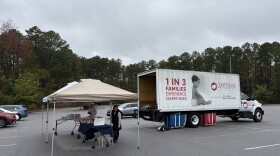Rashmi Patel is at the wheel of an electric-powered shuttle, but not for long. The vehicle is one of two shuttles making history at Fort Bragg as one of the Army’s first autonomous vehicles.
“All right, let me know when you’re belted in,” said Patel, on a recent afternoon. “I’m your chauffeur for today.”
The shuttles began operating last year but until recently were solely driven by humans. Now, there’s a safety driver ready to take over, but the shuttles are piloting themselves, even though they don’t travel far.
“The system can be run both human or robot,” said Patel, a senior engineer on the public-private project. “I switched it to robot, put it on its path and told it to go to [the] Raleigh Road entrance of Womack Medical Center.”

The route -- between the barracks for injured and chronically-ill soldiers and Womack Army Medical Center -- is less than half a mile. And these first vehicles aren’t much to look at. Essentially, they’re large golf carts.
But like a lot of flying drones, the innovation isn’t the vehicle itself, but rather the sensors and software that guide it. And this shuttle works differently from the self-driving cars that automakers are building.
“They rely very heavily on GPS to know where they are,” said Edward Mottern, project manager for contractor Robotic Research. “This system is so advanced it doesn’t need GPS...it knows where it is by looking at the environment.”
Mottern said the shuttles have lots of different kinds of sensors: traditional radar, laser radar, cameras, as well as sophisticated programming.
“What it’s doing is seeing things in the environment, it recognizes them,” Mottern said. “And what it’s saying is these permanent structure will never be moving. And when it’s being them, and when I see them, I know exactly where I am on the road.”
Mottern said this technology has been in the works for years for combat vehicles, but that the more controlled environment on bases means it could be put to use here sooner. One robot-driven vehicle could replace up to eight conventional ones, saving millions of dollars a year at Fort Bragg alone, he said.

But soldiers like Spc. Sean-Michael Vail Horn say the vehicles aren’t just some impractical experiment. He lost his leg in a traffic accident last summer and has been using the shuttles at least twice a week to get to his appointments. He can’t imagine not having the shuttle.
“For me, as well as a lot of other soldiers it would be a lot more difficult,” Vail Horn said. “I mean, we have several hundred soldiers here, and there’s appointments throughout the whole day. Not everybody can drive. Not everybody can walk.”
As he rode along, Vail Horn said it’s hard not to think about the possibilities.
“It’s about time,” he said. “We keep seeing it in movies and now we actually get to see it here at work.”
And the shuttle does work. As it pulls up to an intersection, it stops to wait for a car that has right of way, but doesn’t move. The shuttle has to stop twice before the car finally turns in front of us and drives away.
It ran into that human situation where nobody wants to go first. And it stops at a stop sign on its own.
“It has to obey the law, right?” Patel said. “You want this vehicle to operate as a human would so that other people around it would operate normally as well.”
A few minutes later, the vehicle is back at the parking deck.
“Ok, I’m going to go ahead and switch over to human and take us back in the garage,” Patel said.
And with the flick of a switch, a living, breathing driver is in control again -- at least for now.










